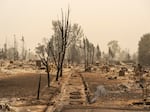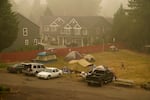Top officials in Oregon are applauding the quick approval by the White House of Gov. Kate Brown’s request for a major disaster declaration.

Smoke rises from the ground in a neighborhood destroyed by wildfire on Sunday in Talent, Ore. Hundreds of homes in Talent and nearby towns have been lost due to wildfire.
David Ryder / Getty Images
Rep. Suzanne Bonamici, D-Beaverton, noted the approval in a tweet saying she appreciated it was done quickly “so we can promptly send more help where it is desperately needed.”
Rep. Greg Walden, the only Republican in Oregon’s delegation connected the speedy approval to a meeting he held with President Trump this week.
“On Monday, I spoke with President Trump and urged swift approval of Oregon’s Major Disaster Declaration and I am grateful for his quick response,” Walden said in a press release. “This declaration will help make assistance available to both individuals devastated by the fire and our communities across the state as they recover and rebuild.”
Oregon requested public assistance for 24 counties - virtually all of western as well as parts of central and eastern Oregon - in its disaster declaration request, as well as individual assistance for eight of the hardest-hit counties, including Clackamas, Jackson, Lane and Marion counties.
Fire resources and information
These online tools offer up-to-the-minute emergency information on wildfires, evacuations and air quality in the Pacific Northwest:
- The EPA’s Air Quality Index: Hourly updates of local air quality readings.
- BlueSky Canada has an interactive map of wildfire smoke forecasts across the Pacific Northwest.
- Northwest fires and evacuations: Oregon’s RAPTOR Map shows wildfires across the U.S. West and evacuation zones within the state.
- Major Oregon and Washington fires: The Northwest Interagency Coordination Center shares this map of major fires in the Pacific Northwest
- Here are some practical tips — including a packing list — on how to prepare for a wildfire evacuation.
- PublicAlerts.org provides links to sign up for emergency phone and email alerts across the Portland-Vancouver metro area.
- Outside the greater Portland metro area, alerts are handled by local governments. Search “Emergency Alerts” and your county’s name to find a link.
Poor air quality remains as officials see progress in fighting Oregon wildfires
A week after fires exploded onto the western Oregon landscape, forcing thousands from their homes and scorching hundreds of structures, fire officials see reasons for optimism. But they said recovery will take patience and leveraging resources.
The total number of deaths remains uncertain, after reports that at least one presumed fatality may have been misidentified. Oregon officials said they will clarify and confirm numbers later Tuesday.
The weather is not cooperating. That means smoke should stick around until the end of this week. Officials report the dense smoke has limited the ability of aircraft to assist in fighting the fire. An air quality advisory for the Northwest has been extended through at least Friday.
People can experience short-term health problems when dealing with this much smoke.
Here’s what the prolonged smoke may mean for human health.
Related: When will smoke clear out of Northwest skies? Not as soon as we’d all hoped

Shayanne Summers holds her dog Toph while wrapped in a blanket after several days of staying in a tent at an evacuation center at the Milwaukie-Portland Elks Lodge, Sunday, Sept. 13, 2020, in Oak Grove, Ore. "It's nice enough here you could almost think of this as camping and forget everything else, almost," said Summers about staying at the center after evacuating from near Molalla, Ore., which was threatened by the Riverside Fire.
John Locher / AP
Status of Oregon Fires
Brattain Fire: The Brattain Fire near Paisley in Lake County was at 34,000 acres and 15% contained as of Tuesday afternoon. Oregon Gov. Kate Brown invoked the Emergency Conflagration Act on Monday to direct more resources toward the fire. On Monday, the fire grew by 22,000 acres, making it five times its previous size. Strong, gusty winds prompted a red flag warning, and evacuation orders were issued for Paisley and nearby communities as of 9 a.m. Monday. Winds between 10–15 mph and high temperatures are expected to continue Tuesday.
Archie Creek Fire: Smoky weather and an inversion have caused poor visibility and hampered firefighting efforts on the Archie Creek Fire burning east of Roseburg. Blocked roads made it difficult to access several areas, but crews say damage assessments are ongoing and progress is being made. In some areas, containment lines were breached by spot fires, and crews are building new lines attempt to stop the fire from advancing further. As of Tuesday morning the fire was over 120,000 acres and 15% contained.
Beachie Creek Fire: Evacuation orders were removed or downgraded Monday for several small communities in Marion County as firefighters continued to improve fire lines and mop up hotspots. Towns in the Santiam Canyon remain under Level 3 evacuation orders. The fire has burned almost 200,000 acres and was only 15% contained as of Tuesday morning. Officials say the increased fire size is not due to increased burning: An aerial survey was completed Monday, giving a more accurate size estimate. The Beachie Creek Fire and Riverside Fire remain 1 mile apart. Though they have not merged yet, officials say it remains a possibility as dry conditions continue. Falling trees and rock slides are creating dangerous conditions in the Santiam Canyon, and the county said it’s no longer safe for residents of Level 3 evacuation areas to visit their homes to feed and care for livestock.

Evacuees from the Riverside Fire stay in tents at the Milwaukie-Portland Elks Lodge, Sunday, Sept. 13, 2020, in Oak Grove, Ore.
John Locher / AP
Holiday Farm Fire: The Holiday Farm Fire is over 166,000 acres and just 6% contained as of Tuesday morning. Crews are working to shore up fire lines around structures in the burn area. An inversion reduced visibility throughout the area and created a “super fog,” where water droplets mixed with wildfire smoke. The inversion could lift Tuesday as a front moves in, potentially increasing fire activity.
Riverside Fire: Crews continue to work to contain the northern, southern and western spread of the Riverside Fire, which is burning a half-mile from the city of Estacada. The fire lines set near Estacada continue to hold, and crews will continue to work to strengthen them Tuesday. They hope to make progress creating another fire line along Highway 242. Hotspot activity remains frequent. The fire is over 135,000 acres and 0% contained as of Tuesday morning. No new evacuation orders have been issued, but the fire is expected to continue to move northwest toward Estacada.
Lionshead Fire: The Lionshead continues to actively burn on both sides of the Cascades, threatening nearby communities. The fire grew Monday, driven by southwest winds and the terrain, and “unusually active” fire behavior continued overnight. Active fire behavior is expected to continue today. Crews will patrol the fire line on the eastern edge. Crew members say mop-up along that edge has been completed, but crews will remain in case any other fires pop up. In Idanha, Detroit and Marion Forks, crews continue to focus on protecting structures, mopping up hotspots, and containment. It is over 168,000 acres and just 5% contained as of Tuesday afternoon.
Almeda Fire: Residents are returning to burned areas around the Almeda Fire, though conditions in Level 3 evacuation areas remained dangerous. There have been no changes to the evacuation zones in the last three days. The Mail Tribune reports the fire is 100% contained as of Tuesday morning.
Obenchain Fire: Residents were allowed to return to Shady Cove and parts of Eagle Point, when evacuation levels were reduced to Level 2 Monday. But that may change as the fire is expected to continue to grow toward the south and east. Southern winds Monday allowed the fire to occasionally breach containment lines. The Obenchain Fire is 32,000 acres and 20% contained as of Tuesday morning. Find more on the South Oberchain Fire from JPR.
Echo Mountain Complex: Crews were working to complete the final fire line around the Echo Mountain Complex Fire Monday. It was burning almost 2,500 acres and was 35% contained. Rain is expected Tuesday, aiding in firefighting efforts. There have been no changes to evacuation levels issued as of 8 a.m. Tuesday.
Smoky air here through Thursday
Wildfire smoke breaks record numbers throughout Oregon and the smoke is expected to linger in the air through Thursday.
The Department of Environmental Quality and Lane Regional Air Protection Agency released data from the past week that shows historical record-breaking air quality levels in five of Oregon’s most-populous cities: Portland, Eugene, Bend, Medford and Klamath Falls.
The agencies used an Air Quality Index which categorizes and scales air quality from 0-500 and from good, moderate, unhealthy, very unhealthy or hazardous. Each of the five cities exceeded previous daily records for poor air quality during wildfire season with the most previous records set in 2017. All cities reached unhealthy or hazardous levels after the Labor Day firestorm and the dense smoke is expected to remain throughout most of Oregon until at least Thursday.
State leaders: Weather brings optimism even as Oregon fires rage
Gov. Kate Brown and state fire officials continued to express optimism Monday that Oregon will make progress tackling dozens of fires burning throughout the state.
Brown announced the creation of the 2020 Community Rebuilding Fund led by three of the state’s largest foundations — the Ford Family Foundation, the Meyer Memorial Trust and the Oregon Community Foundation.
Brown also pressed for more federal assistance Monday, announcing she had requested a “presidential disaster declaration” from President Trump, following a federal emergency declaration she had requested and had approved last week.
In a press conference earlier Monday, fire officials said thousands of firefighting personnel have taken advantage of favorable weather to make “outstanding” progress on some of the most destructive fires in state history.
Just as the recent progress has been helped by quieter winds, greater moisture and lower temperatures, the next few days will also depend largely on what Mother Nature brings.

A view of downtown Portland from the East Bank Esplanade is seen on Monday, Sept. 14, 2020. The entire Portland metropolitan region remains under a thick blanket of smog from wildfires that are burning around the state and residents are being advised to remain indoors due to hazardous air quality.
Gillian Flaccus / AP
Brown points to wildfires as reasons for vetoing lines of budget bills
Brown will veto a number of budget adjustments passed by legislators last month, restoring planned cuts to a handful of state agencies while scrapping $100 million lawmakers had earmarked for emergency spending.
Brown issued a notice of the line-item vetoes in two budget bills Monday afternoon, touting the move as a way to keep more money in state coffers while funding a response to dozens of wildfires burning in the western part of the state. Brown is required under the state constitution to provide at least five days' notice before issuing vetoes.
Related: Gov. Kate Brown announces vetoes to help fund wildfire response